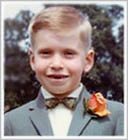An Illustrated History of Old Sutton in St Helens, Lancashire
Part 33 (of 95 parts) - Leisure & Entertainment in Sutton
d) Sutton's Show Field | e) Sutton 'Bug' Picture Palace | f) Wireless, Television & Rediffusion
g) Blinkhorn Parish Room | h) Sutton's Social & Leisure Clubs | i) St Helens / Sherdley Show
Researched & Written by Stephen Wainwright ©MMXX Contact Me Research Sources
The Rise of the Excursionist | Parks of Sutton
Sutton Show Field | Sutton Bug Picture Palace
Wireless, Television and Rediffusion in Sutton
Blinkhorn Parish Room | Sutton's Social Clubs
The St. Helens / Sherdley Show (1968-2006)
Researched & Written by Stephen Wainwright ©MMXX
Old Sutton in St Helens
Rise of the Excursionist
The Parks of Sutton
Sutton’s Show Field
Sutton Bug Picture Palace
Wireless, TV & Rediffusion
Blinkhorn Parish Room
Sutton's Social Clubs
The St. Helens Show
Early Closing and 'Moral And Social Improvement'
Historically, leisure and entertainment in Sutton, like most of the rest of the country, was centred around feast days and holy days, the latter, of course, being the derivation of 'holiday'. There were between twenty and thirty such days per year and they were enthusiastically embraced by all. Long working hours meant that there was not much time for fun and many spent what little leisure time they had down the pub. Many workers were even paid in their local, as opposed to their place of work, and by 1871, the year Bank Holidays were introduced, Sutton had 20 public houses and 19 beerhouses.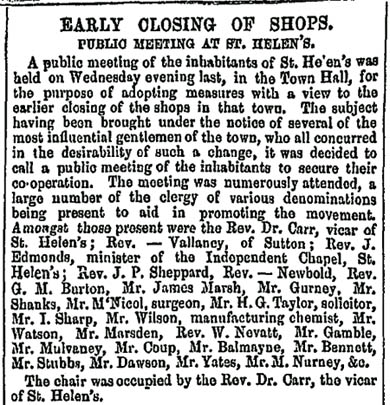
On Saturdays, shop assistants regularly laboured until midnight or even later, as that was the day when workers were paid and so had money to burn. If the hours of the many shop assistants could be reduced by curtailing opening hours, then they would be able to indulge themselves in more leisure activities. So an early closing campaign began in 1855, led by Rev. Edward Carr, the vicar of St Helens and supported by Sutton's Rev. Henry Vallancey.
A public meeting was held in the Town Hall on November 21st, in which reference was made to other movements to improve the 'social, moral, intellectual, and religious well-being' of St.Helens people. Rev. Carr chaired the meeting and proposed the closing of shops at 7 or 8pm on weekdays, with 10pm the limit on Saturday night, saying that incessant labour made men 'bilious and ill-tempered'. Countering criticism that closing early would give young men more time to drink and gamble, Rev. Carr argued that they would instead indulge in healthy pursuits:
However the 1855 Town Hall meeting which didn't itself end until 11:30pm, set the tone for the rest of the century and beyond. There was now a consensus that more had to be done by the church and the St Helens community to reduce working hours, combat excessive drinking and create meeting places for young men. Presumably gentile women were expected to take care of themselves! The powers-that-be in the town wanted to stimulate leisure activities and more edifying pursuits like listening to music and lectures; or as one speaker put it at the meeting, create "moral and social improvement".
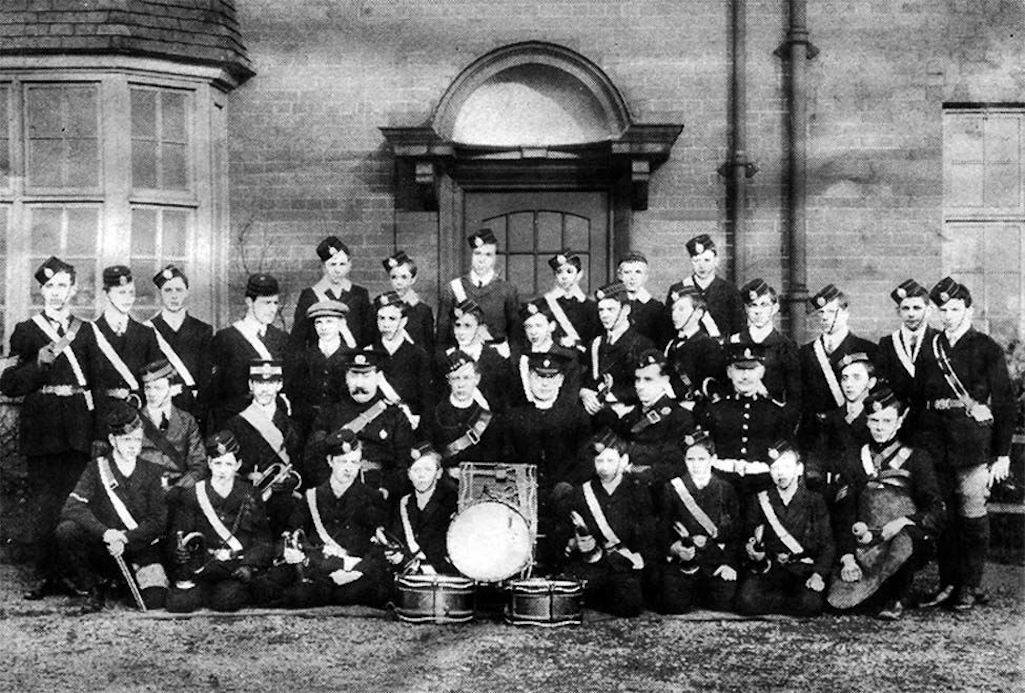
The Sutton Church Lads Brigade pictured in 1911 - behind the drum and to the right is Rev. W. E. Colegrove

Sutton Church Lads Brigade in 1911, probably outside Sutton Vicarage

Sutton Church Lads Brigade in 1911
Church youth activities were strongly encouraged with groups such as the Church Life Brigade, Catholic Lads Brigade, Jewish Lads Brigade and the Band of Hope. Their ethos was to instil 'obedience, reverence, discipline, self-respect and all that lends towards a true Christian manliness'. The photograph above from 1911 shows the Sutton Church Lads Brigade founded in 1891 as the Anglican version of the Boys Brigade and attached to Sutton Parish. Sitting behind the drum and to its right is Reverend W. E Colegrove, Vicar of Sutton. A curate, probably the Reverend T. Holme is also pictured, along with Alfred Emblem. The organisation is still going and now known as the Church Lads & Church Girls Brigade (CLCGB).
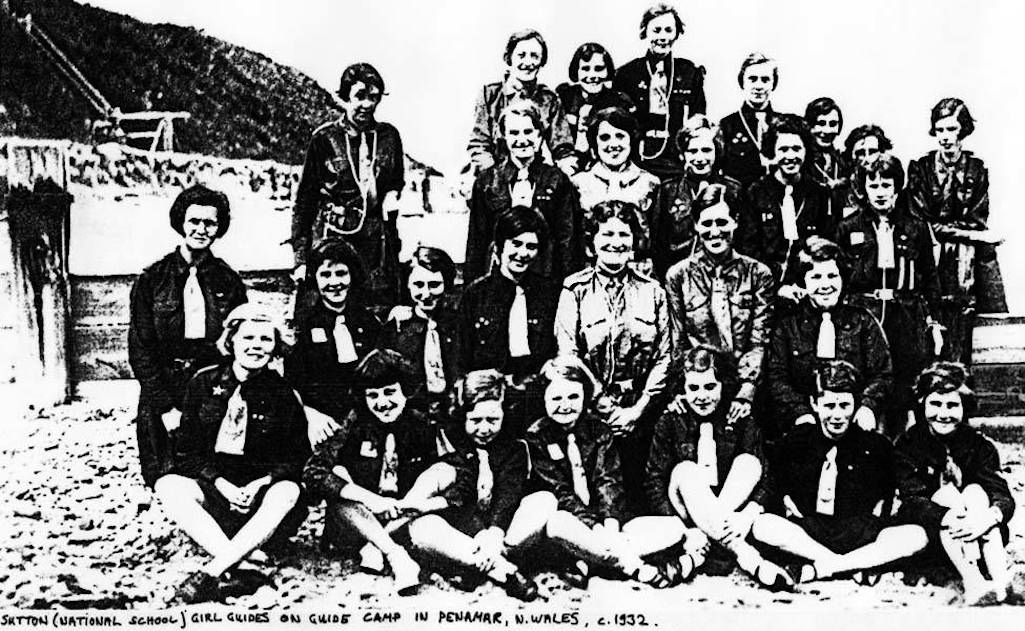
The Rise Of The Sutton Excursionist
As well as promoting wholesome leisure activities within Sutton and St Helens, the church, community organisations and the works' bosses, also organised day-trips with travellers referred to as 'excursionists'. The advent and expansion of the railway during the 19th century led to a big increase in day-tripping with the annual visit to Newton Race Week the highlight for many. Race Friday was particularly popular with a special train put on from St.Helens that stopped to collect Sutton passengers at Peasley Cross, Sutton Oak and St.Helens Junction stations. Rev. Thomas Pigot, the vicar of St Helens Church, warned against the "sad excesses" of Newton Races in a letter to the Liverpool Mercury (13/2/1835) saying that many poor sinners: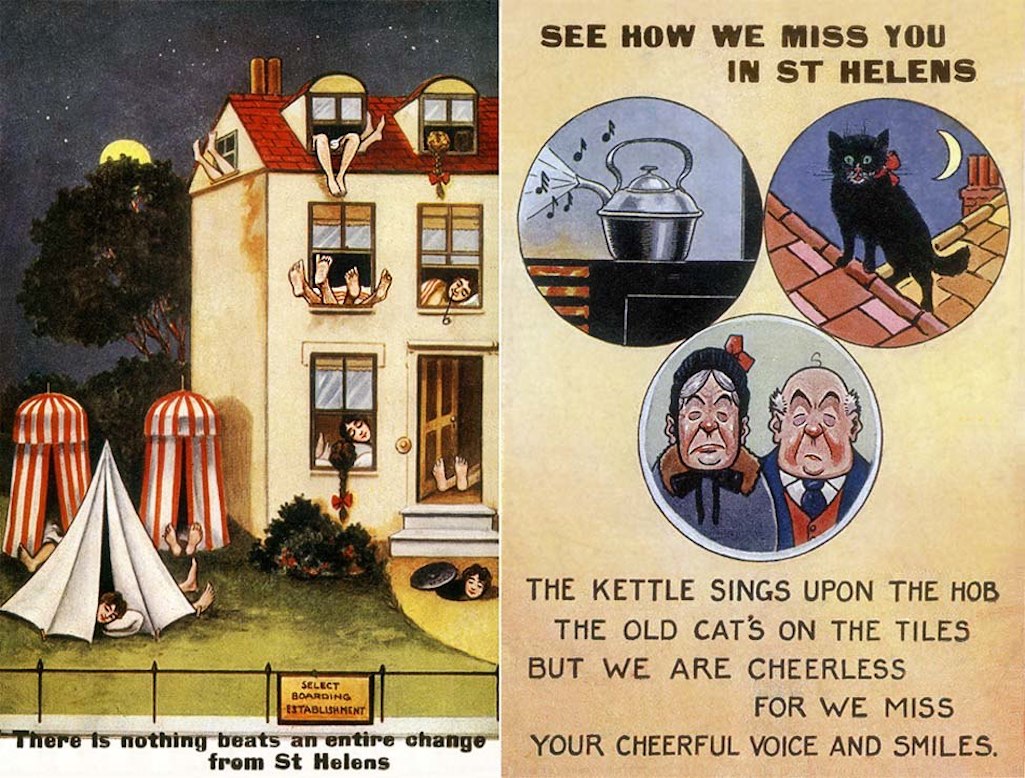
Two postcards posted in 1920 from St.Helens to Blackpool! - the one on the left satirises overcrowding in St.Helens

Two postcards that were posted in 1920 from St.Helens to Blackpool!

Postcards that were posted in 1920 from St.Helens to Blackpool!
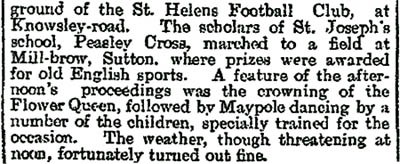
For those who remained at home, a number of festivals and field days took place, including one in a field at Mill Brow, Sutton. This was organised by St. Joseph's school of Peasley Cross where 'prizes were awarded for old English sports'. A Flower Queen was also crowned and Maypole dancing took place. As well as Whit, August Bank Holiday was another popular time for organised excursions, then held on the first Monday of the month.
Towards the end of the 19th century cycling became increasingly popular, although the early 'boneshakers' were expensive to own. The members of St. Helens Cycling Club, formed in 1876 by (Sir) Joseph Beecham and W. J Ashton, must have been quite well off with early machines costing £20 - about £1000 in today's money. However excursionists could hire a machine for a few hours recreation, although this could lead to inexperienced riders on poor quality bikes being a menace to pedestrians.
On Whit Monday 1896, engine driver John Smith from St Helens Junction was knocked down by Robert Cutler from Blackburn whilst crossing Southport promenade and later died from his injuries. Cutler was riding a hired tricycle for the first time and said that it had a defective bell. At Smith's inquest held on June 1st at Sutton's Wheatsheaf Hotel, which was then in Lionel Street, the coroner Samuel Brighouse declared that: "All the old 'crocks', with the worst bells are hired out in the place". The Chief Constable of Southport was said to be taking 'energetic steps to put down furious riding', however the Sutton inquest jury felt that much more needed to be done and they called for Southport Corporation to licence and control bicycle hirers.
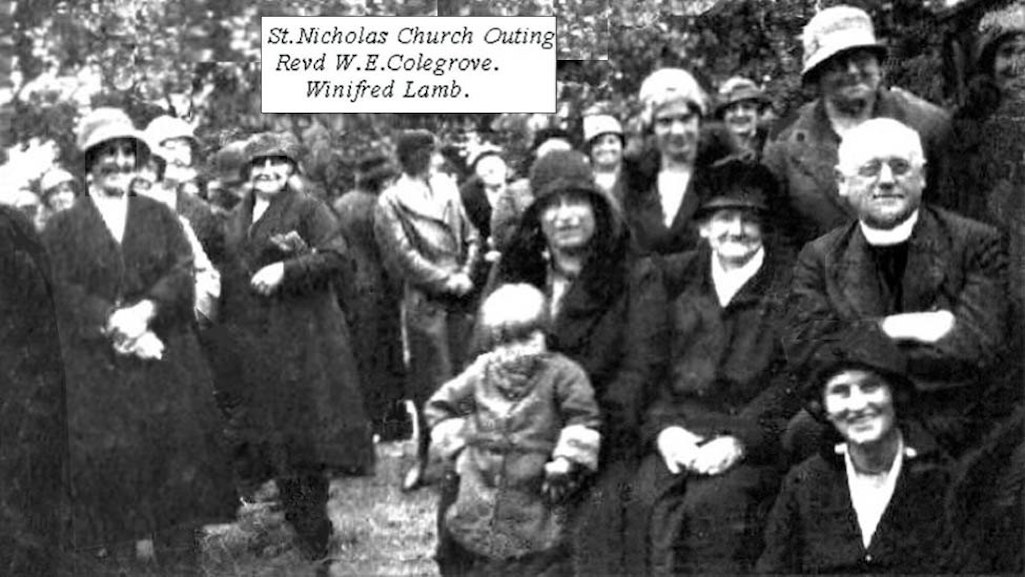
Sutton Vicar Rev. Colegrove with parishioners in the 1930s on a church excursion (contributed by James Lamb)

Sutton Vicar Rev. Colegrove with parishioners in the 1930s

Sutton parishioners on church excursion
The Parks Of Sutton
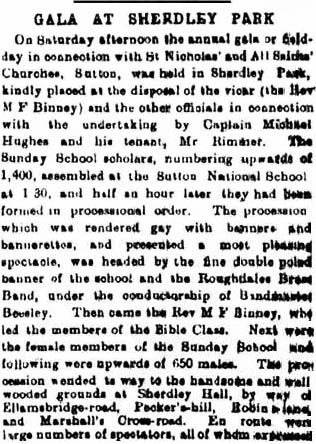
The girls had to content themselves with a skipping competition for the under 12s, 100 yards flat race for under 14s and a potato and spoon race for the over 14s. Running and jumping was presumably not considered very ladylike for the young females! Prizes for the winners were donated by Michael Hughes of Sherdley Hall and his Sherdley estate manager Henry Campbell. On July 18th 1930, the St.Helens Reporter claimed that the 1,300 participants who processed to Sherdley Park for that year's Sutton Parish gala or fête was a record. However it was actually one hundred less than the number who took part in 1895. The newspaper's correspondent described Ellamsbridge Road as having been turned into 'a fairyland' by the colourful spectacle and in the park itself, country dances and the usual sports were performed by Sutton National schoolchildren.
As well as annual parish and school events, Sherdley Park also hosted special events, such as the Sutton Coronation Bazaar Fête on July 8th 1911 and a Red Cross Fête and Gala on 5th, 6th, 7th & 9th September 1918. The former was to commemorate King George V's coronation at Westminster Abbey a fortnight earlier. A field in the park known as 'The Annexe' was often used for events.
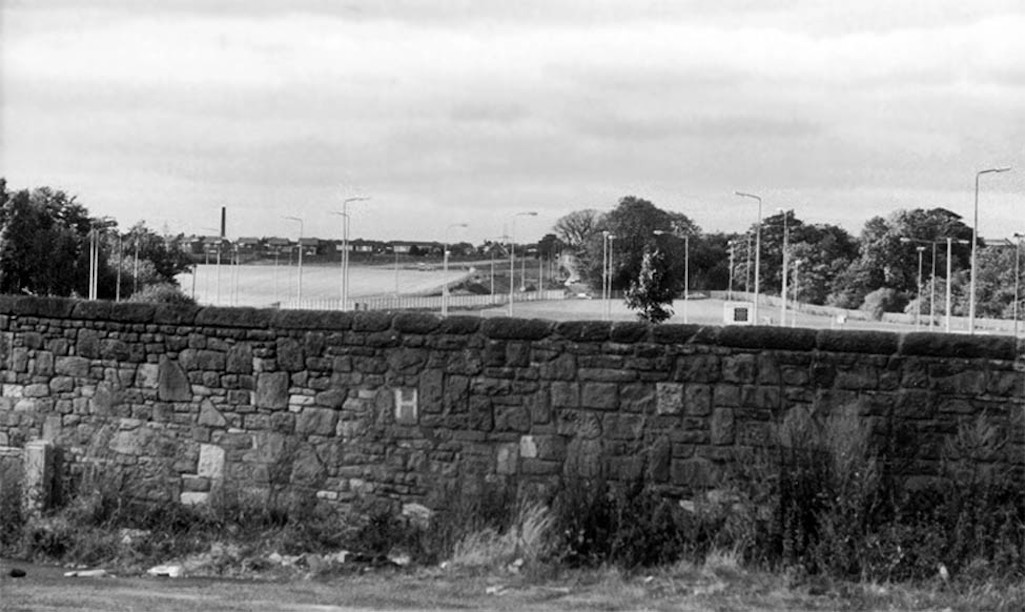
'Long Wall' in 1950 in Marshalls Cross Road - Sutton Academy now occupies the field - Contributed by Jim Lamb

Part of the ’Long Wall' in 1950 in Marshalls Cross Road

'Long Wall' in Marshalls Cross Road
The Vicar of Sutton Rev. Binney chaired the meeting and said that parks, baths and music had been provided for the opposite ends of the town. However Sutton and Parr only had two branch libraries, an infectious diseases hospital and a 'graceful sewage destructor'! Then in July of 1897, Rev. Binney wrote to Col. Richard Pilkington, the Mayor of St.Helens, asking that the Council provide a band to play in Sutton once or twice a week during the summer, as happened in other parts of the borough. However having no park or bandstand in Sutton that could accommodate musicians was a considerable handicap for such an arrangement.
On October 27th 1897, John Willis - the prospective Liberal candidate for East Sutton ward in the forthcoming council elections - complained about the lack of a park at three open air meetings. These took place in Rolling Mill Lane, Baxters Lane and near Sutton Oak station. Willis said that if ratepayers wanted to visit their nearest park, they had a journey of four miles to make. He claimed that the district had been neglected by the Corporation and promised to fight for a public park in Sutton if elected. Five days later Willis won the election by 77 votes and became one of East Sutton’s council representatives.
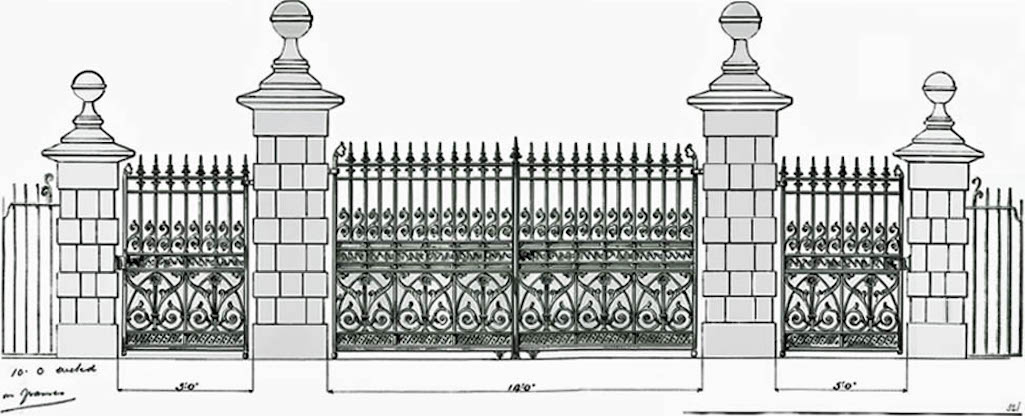
Illustrations of the Sutton Park gates which were removed during the second world war

Illustration of Sutton Park gates which were removed during World War 2

Illustration of the Sutton Park gates
This was purchased from Michael Hughes on May 9th 1903 for £2,628, who insisted on a clause in the agreement that stipulated the type of entrance gates that had to be constructed for the new park. These needed to be of a ”handsome type with pillars of stone of a massive character and be maintained as such forever". So plans were submitted for stone pillars and 14 foot 3½ inch wide cast iron entrance gates costing £52 10 shillings.
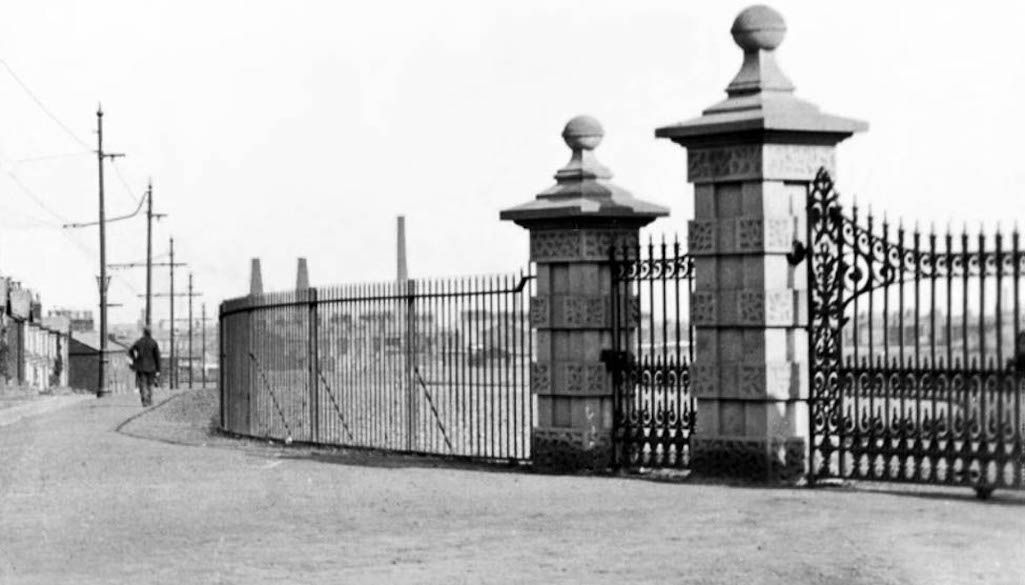
A partial image of the gates and stone pillars at the entrance to Sutton Park with Robins Lane on the left

A partial image of the gates and stone pillars at the entrance to Sutton Park

Gates and pillars at the Sutton Park entrance with Robins Lane on the left
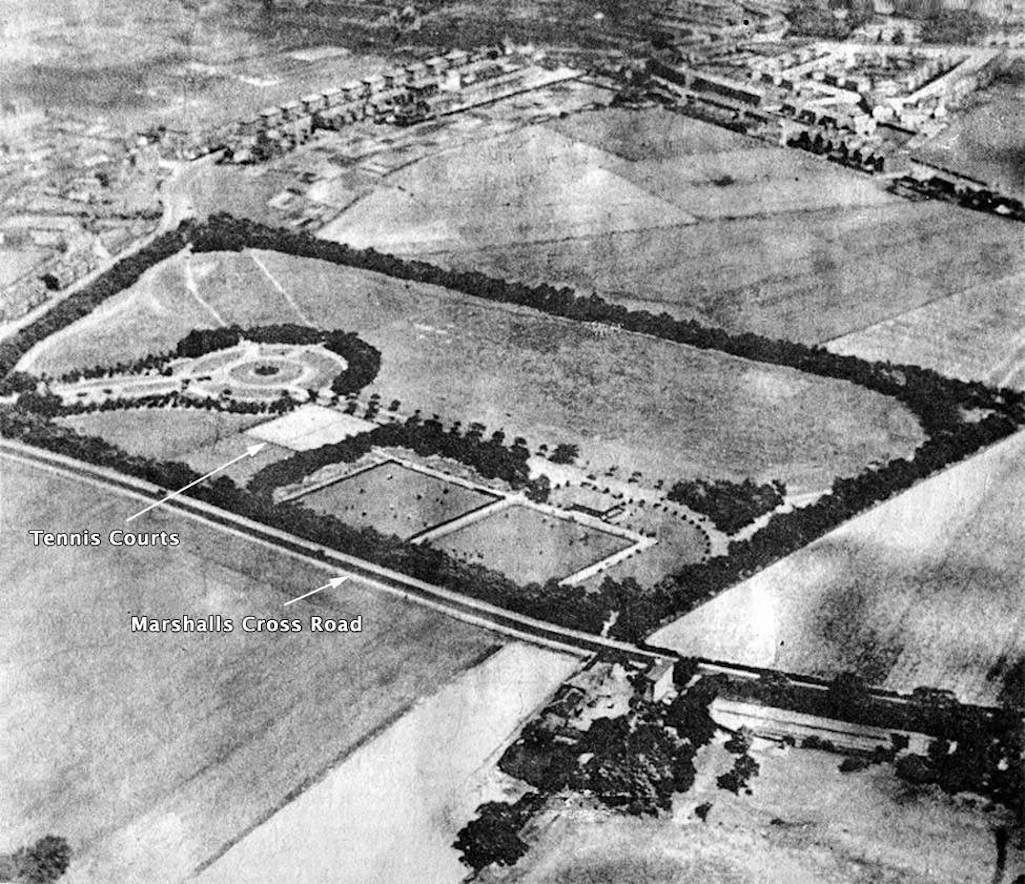
An undated aerial photograph of Sutton Park but it was probably taken during the 1930s

Undated aerial photograph of Sutton Park, probably taken during the 1930s

An aerial photograph of Sutton Park
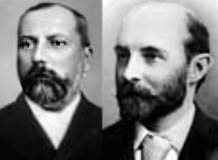
It was revealed that the full cost of creating Sutton Park had been £5,691, including its purchase price, laying out, fencing, gates and diversion of the brook. The Mayor proudly announced that the new park was the seventh that St Helens Corporation had provided for the town, which in total covered 164 acres. Councillor Martin was presented with a rose bowl as a memento of his opening of the park and Sutton Road Prize Band joined in the celebrations. During the evening there was a large attendance as the brass band continued to perform, with the park staying open until 9pm.
Initially Sutton’s ratepayers had little to see for their money. At the time of the opening, the park was little more than a recreation ground, with the paths not being fully laid out and only a few small shrubs planted. However 3,000 trees and shrubs were to be planted during the Autumn and a bowling green and bowls house were scheduled to be ready for the start of the next season. However preparing the green took longer than expected and its official opening took place on September 4th 1907.
The Mayor of St Helens was now Charles Bishop who in performing the opening, revealed that he’d been born some 400 yards from the park. The chairman of the Parks Committee, Councillor Peet, presented the Mayor with a commemorative set of bowls and jack and commented how the green would, in a year or two, equal any in Lancashire. The bowls house - which the St Helens Newspaper said was "a very neat one" - was erected by builders Godel Waizbom and Son of St Helens.
A drinking fountain and bandstand were also incorporated soon after Sutton Park opened, with an additional bowling green created in 1914 and tennis courts added in 1924, adjacent to the greens. If bowlers did not have their own bowls, they could be hired from a hut. A nine-hole putting green near to Marshalls Cross Road was also added at some point. As described in the Sutton Park 'Beauty' page the glacier boulder at the Marina Avenue entrance, is believed to be at least 12,000 years old, having been brought down from the Lake District (or possibly Scotland) by ice glaciers. There used to be iron railings surrounding the stone with a plaque informing visitors of its origin. In fact iron railings surrounded the whole park, which was locked at night and attended to by park-keepers.
Large numbers of Suttoners embraced their new park enthusiastically. This was especially so on some Sundays and summer evenings when band concerts took place. St Helens Council began organising these in 1914 and at first just three concerts were held over the summer at a cost of £2 15 shillings each. Later band and dancing performances took place on weekday nights.
In Charles Forman's book 'Industrial Town - Self Portrait of St Helens in the 1920s', an interviewee born in 1895 described dancing in Sutton Park on Tuesdays. The unnamed woman said: "There'd be a big band there, and in the park the children came from everywhere". The St Helens Reporter of 22nd July 1930 described a performance in Sutton Park by St. Peter's from Parr:
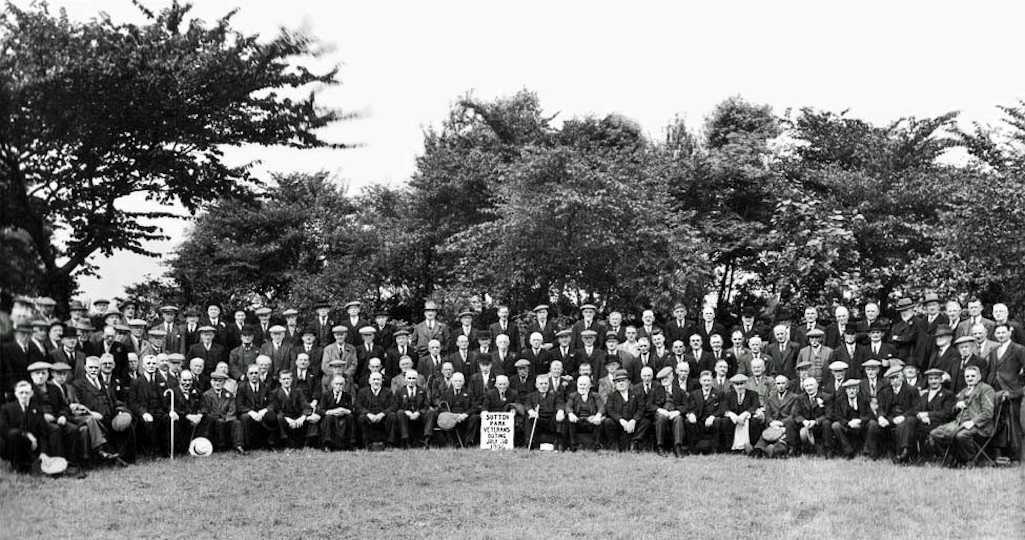
The Friends of Sutton Park organised veterans' outings such as this party in 1950

The Friends of Sutton Park organised veterans' outings, such as this from 1950

The Friends of Sutton Park organised veterans' outings like this from 1950
A popular feature in Sutton Park was the rose garden, which was accessed from the "rose path" that led from a flag pole. During WW2 allotments were created within the park to boost food production and an Anderson shelter gave locals protection against air-raids.
Youngsters, of course, didn't require an actual park to play in. Anywhere would do, especially if there was open space. The Ellen Street field was a popular venue for kids who enjoyed playing cricket, football, rugby, piggy, 'chucky', 'duck off' and hop, skip and jump. These days the site is occupied by East Sutton Labour Club and Ellen Gardens. Another popular playing field was on the corner of Ellamsbridge Road (originally this was Gerards Lane) and Robins Lane and was given the nickname of 'Joe Doffs', although the origins of the name have not been established.
Joan Heyes lived in Ellen Street from 1919 and recalls her childhood fun in Joe Doffs. Writing to this website through daughter Brenda, 94-years-old Joan said:
Sutton's Show Field and The 'Injun Village
'The 'Show Field' or 'Show Back' was a rectangular piece of grassless ground, 100 yards long by 50 yards wide, sandwiched between the rears of Edgeworth Street, Peckershill Road and Robins Lane and, at its opposite end, by Fisher Street and Taylor Street. At various times of the year, the Show Field was inhabited by travelling show folk of all kinds, who put on circuses, animal shows, fairgrounds and boxing bouts. However, the animal or 'wild beast' shows led to complaints from Robins Lane residents who didn't like the noisy lions and tigers disturbing their sleep! So from around 1920 these were stopped.In Frank Bamber's 'Clog Clatters in Old Sutton' and in his contribution to a 'Whalley's World' article in the St.Helens Star (5/11/1998), he describes the children's wide-eyed excitement when the merry-go-rounds, swinging boats, Wild West shows and coconut shies were crammed onto the Show Field.
Frank also relates how on one morning about 1916, his two older brothers hurried him through the front door of their home at 64 Edgeworth Street to witness an elephant, led by its trainer, walking through the streets of Sutton. From time to time it stopped to accept crusts of bread and cabbage leaves from the crowd of onlookers that thronged the pavement:
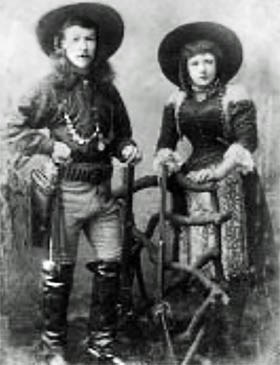
On December 8th 1919 the Licensing Justices in St Helens considered an application from Edward Silcock for a music licence for the Show Field. Silcock wanted a licence to play his barrel organs in order to attract punters to his other amusements. However a number of residents from Robins Lane were in court to object. Railway signalman John Gibbons said he did shift work and the noise during the day prevented him from sleeping. He also complained of an "abominable nuisance" that was created by large numbers of people flocking to the place and no toilets for half a mile. Mr Gibbons added that it was unfit for ladies or children to go out of their back doors while the shows were on.
A resident called Mrs Turner said she objected to the "noise of the rabble and the so-called music grinding for hours together." She said in the past the music had been playing from six o’clock until ten or eleven, five days a week, and then until midnight there was the sounds of a shooting gallery. "The last time we were nearly driven to distraction", she added, complaining of the sound of the trams at the front of the house and then the noise of the fair at the back. The magistrates said they had given careful consideration to the application and unanimously decided to reject the application.
Some waste ground near the hospital in Peasley Cross was also used for animal attractions, such as on September 26th 1919. Then Sanger's Circus and Menagerie came to town, promising: "The latest novelties, sensational thrills & marvels of this wonderful world." There were African snake charmers, "almost human" sea lions and a group of Indians led by Lone Face described as "the only savage troupe of riders in Europe". One of the lesser-known facts about WW1 was the use of elephants in agriculture and industry to replace horses requisitioned by the military. Sanger's elephants spent four years engaged in war work and in their show there was a special display of the beasts ploughing, reaping and sowing.
In those days a powerful team of horses was required to haul the fairground rides, side-shows and circus marquees to their destinations and the show people had a dilemma as to where to keep them until it was time to move on. Once Sutton's shows were set up, the horses were led down Junction Lane and under the railway bridge into Helena Road and Bold Road and finally into an open farm field at the end of Hills Moss Road. There tents were erected for the minders to watch over the grazing horses, which led to Sutton folk giving it the nickname of "th' Injun Village".
The Show Field was a magnet for Sutton village folk and even those living farther afield in Parr, Burtonwood, Clock Face and Sutton Manor. However its entertainment was irregular and noisy, unlike the silent films in Sutton's picture palace, the Sutton Empire or 'Bug'.
 Texas Bill Shufflebottom & Rosina
Texas Bill Shufflebottom & RosinaSutton Bug - Sutton's Picture Palace
In 1913 a new form of entertainment came to Sutton, the picture palace or cinema. However, most of Sutton's citizens would already have been familiar with moving pictures, having seen them at fairs on Sutton's 'Showfield' or at special events. For example a short cinematograph exhibition of silent films was part of the programme for a concert in Sutton National School on February 13th 1900.Alternatively many will have ventured into St Helens and visited the Hippodrome in Corporation Street, which began exhibiting from 1903. Films were also shown on the top floor of the Co-op building in Baldwin Street from 1907 and there was also the Town Hall and YMCA which both regularly screened the 'flicks' from around 1910. The first purpose-built cinema in St.Helens was the Electric Theatre (or Scala as it became) in Ormskirk Street which began in September 1911.
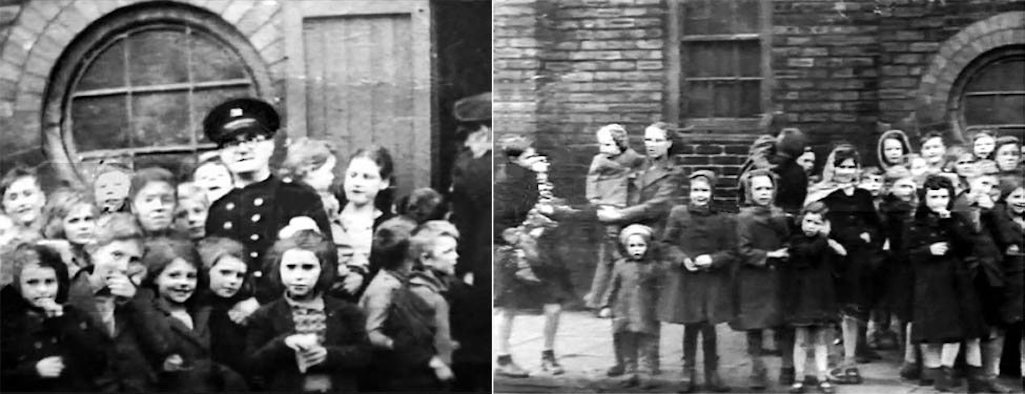
The Sutton 'Bug' Saturday matinee gang outside the cinema with Fireman Tommy Waring

The Sutton 'Bug' Saturday matinee gang with fireman Tommy Waring

Sutton 'Bug' Saturday matinee gang with fireman Tommy Waring
Then on November 9th 1916, manager Edward Westhead was prosecuted for non-payment of entertainments duty. After an undercover visit by an Excise officer, a scam had been uncovered in which purchased tickets were not being torn by cinema attendants as required by law. Instead the Sutton Bug was recycling them to other customers. The duty was being paid via stamps attached to each ticket and the scam meant that the cinema was purchasing fewer stamps than they should have. Westhead denied the offence but was fined £5.
Then on September 24th 1917 the proprietors of the cinema were prosecuted for not having a fireman in uniform at every performance. The police had paid a visit to the Empire and found the regular fireman away and his place taken by a man in civilian clothing. After the police drew this to the attention of managing director Nathan Rothwell, he instructed the man to put on his fireman’s cap, which appeared to be the only uniform that they had. The Chairman of the Bench said the people connected with the theatre seemed to think that they could do what they liked and they must be made to know that they could not. The proprietors were fined £10 and Rothwell was also fined £10 for aiding and abetting. Three weeks later the Sutton Empire was fined 5 shillings for allowing the sale of postcards on its premises by an artiste called Christinia Van Earle after 8pm.
Peter Bates was, for many years, the manager of the cinema and the formidable Miss Bates ran the box-office in her all-black outfit. Mildred McCarthy of Ellen Street was for many years cashier at the Sutton Bug. Tommy Waring was one of the firemen who was renowned as quite a character. The pianist Audrey Barton played mood music for the feature films and sat inside a protective cage, safe from any missiles that might be thrown when a film broke down. Sutton Bug closed in 1957 with the last owner Cliff Withenshaw. Incidentally it wasn't the only licensed picture house within the boundaries of Sutton. On September 12th 1921, the Rainhill County Asylum - as it was then known - was granted a cinema licence for showing films to 'inmates'.
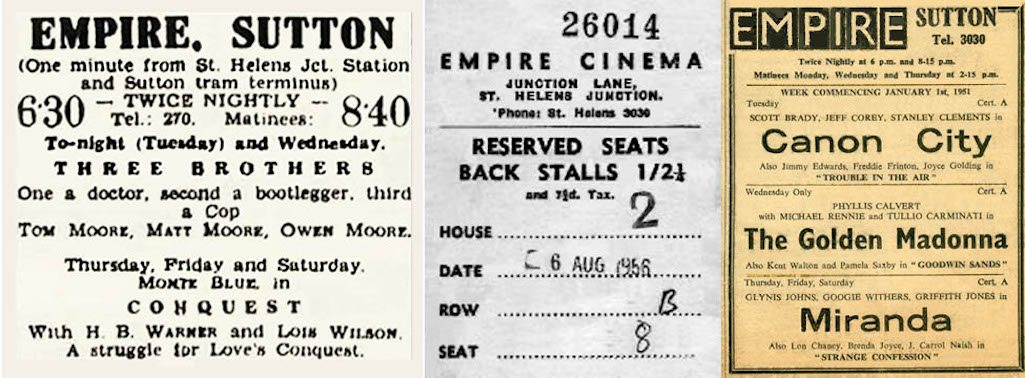
Left: St.Helens Reporter 16/9/1930; Middle: Ticket Contributed by Bob Taylor; Right: St Helens Newspaper 2/1/1951

Left: St.Helens Reporter 1930; Middle: Ticket; Right: St Helens Newspaper 1951

Two Sutton Bug adverts and ticket
Vera Bryant lived in Sutton during her childhood and regularly visited the Sutton 'Bug' picture house:

Relating their Sutton Bug Empire cinema anecdotes in interview in 1993: Jim Brunskill, Eric Coffey and Vera Bryant

Relating their cinema anecdotes: Jim Brunskill, Eric Coffey and Vera Bryant

Jim Brunskill, Eric Coffey & Vera Bryant
The Wireless, Television and Rediffusion
From the 1920s, a few Suttoners were able to purchase early radio receivers, although an outdoor long-wire antenna was required for good reception. An annual wireless licence was also needed to operate the radios, which during the '20s and '30s was ten shillings {50p}. These days there are sophisticated means to detect television licence evasion but during the wireless days of the 1930s, St.Helens post office investigators could simply drive round the town's streets looking for long aerials in back gardens and yards and compare these addresses with their licence records.Offenders could be taken to court, such as James Ward of 10 Baxters Lane, Sutton. In an article entitled 'Wireless Pirates Beware', the St Helens Reporter of February 27th, 1934 described how James had been charged with 'unlawfully working a wireless without a licence', which led to a £1 fine by the magistrates.

Red Rose and E. & R. A. Davies cycle and radio shops plus redundant Rediffusion man-hole cover in Robins Lane

Red Rose & E. & R. A. Davies cycle & radio shops & redundant man-hole cover

Red Rose and E. & R. A. Davies plus redundant Rediffusion man-hole cover
Sutton shops that sold both wireless sets and cycles include The Red Rose at 72 Peckershill Road, which was owned by Tom Williams and E. & R. A. Davies of 47 Junction Lane. Within the town of St.Helens there was Rothery Radio and Frank Waring but the heavy and dangerous lead-acid accumulators gave an early advantage to the local Sutton stores in developing their business. Mention should also be made of Browns of 24 - 28 Junction Lane, who specialised in Burndept Radios.
From December 1949 when the BBC Midlands transmitter at Sutton Coldfield, near Birmingham was switched on for the first time, the possibility of television became available as an additional form of entertainment to rival the Empire cinema. Although some people purchased televisions and aerials from dealers, many Suttoners subscribed to Rediffusion to receive radio and television transmissions. In later twentieth century years, Rediffusion became associated with commercial television franchises and TV rental. However, it began its days as a pioneering cable company with a shop in Robins Lane, in between Peckershill Road and Edgeworth Street.
If you walk down Robins Lane, near to its junction with Ellen Street, and look down, you'll see a remnant of Sutton's past in a redundant Rediffusion man-hole cover. Rediffusion set up their wired networks in many towns during the 1940s and '50s, carrying interference-free services to subscribers. In 1995, Cable North West (now Virgin Media) dug up the streets of St.Helens to install cable television and radio channels in many homes, but Rediffusion had pioneered it years before.
Blinkhorn / Parish Room in Waterdale Crescent
You have to be quite observant these days to spot any traces of the Blinkhorn family, who as glass makers and benefactors were important Sutton citizens during the second half of the nineteenth century. There is an inscription to William I in Gerards Lane, although it's hidden away on the reverse side of Victoria Bridge. Plus dedications to three of the family (William II & first wife Emily Blanche & their daughter Emily Binney) are only visible to churchgoers who crane their heads as they enter the St. Nicholas lychgate entrance.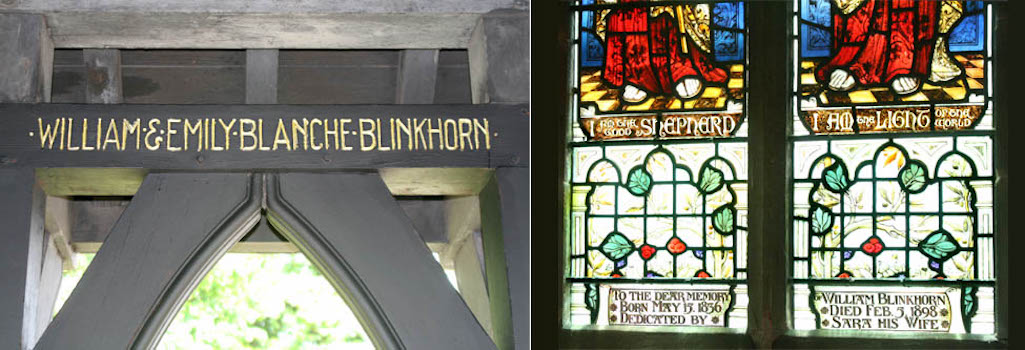
Left: Part of the lettering in the roof of the St. Nicholas lychgate entrance; Right: Section of the Blinkhorn stained glass window

Left: St.Nicholas lychgate; Right: Section of Blinkhorn stained glass window

St.Nicholas lychgate and a section of Blinkhorn stained glass window
The long room was situated within a row of terraced houses - that included the Crystal Palace pub - and was donated to the parish in 1919. A few lines in the St Helens Reporter of January 10th of that year stated that Mrs W. F. Jones, the daughter of the late Mrs Blinkhorn, was buying the Waterdale Parish Room and presenting it to Sutton Parish. Improvements were then set to be carried out.
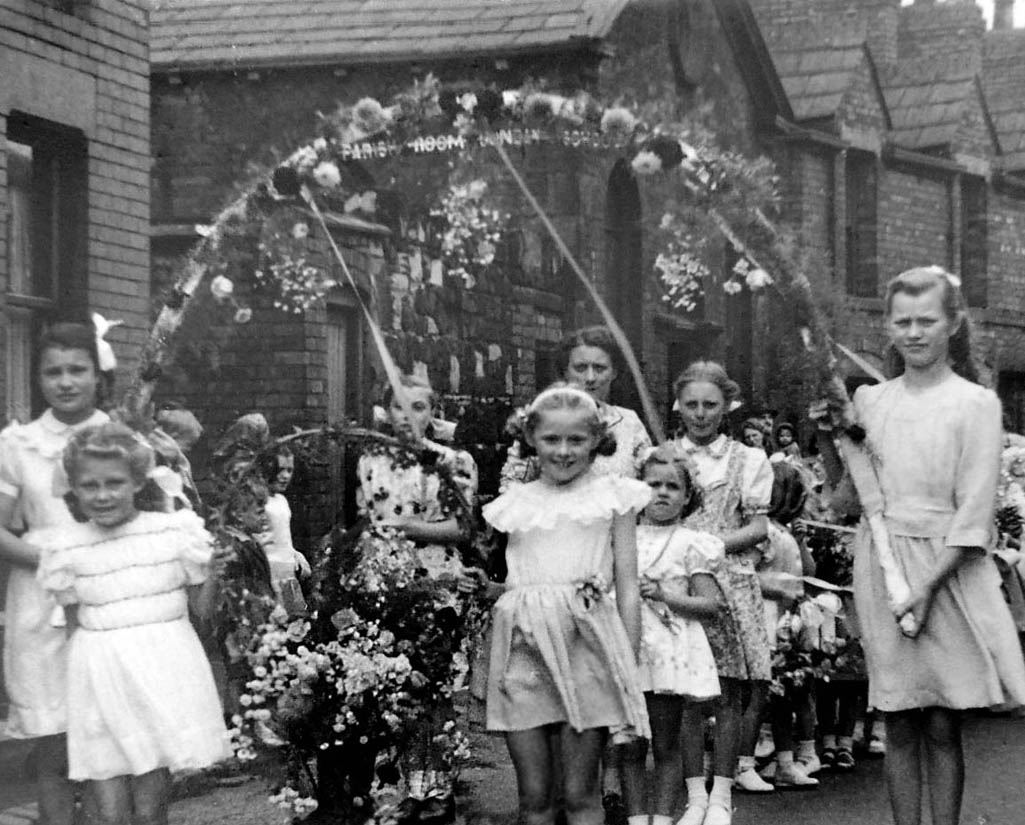
The Blinkhorn Room is pictured in the background of this walking day photograph from 1946 - Contributed by Norris Kenwright

The Blinkhorn Room is in the background of this 1946 walking day photo

The Blinkhorn Room is in the background
One correspondent to 'Whalley's World' in the St Helens Star said that in his day, there was a squad of dinner ladies who served up "plenty of porridge, toast, hot cocoa and lob-scouse". Frank Ashton also described in his letter to the Star how:
Sutton Social Clubs
It's quite astonishing that in the very early years of the 20th century when Sutton Harriers were achieving international success, they were having to use the most rudimentary of facilities in the Red Lion. However by this time club houses were appearing within the Sutton district, often affiliated to political parties. These would soon be greatly expanded as industries such as mining - as well as leisure and sports societies - constructed club rooms for their workers and members. They served as alternatives to the traditional use of snugs and back rooms in pubs as meeting places. Some of these social and sporting clubs and club houses are described on other pages of this website and the Blinkhorn Rooms is featured above. This article will concentrate on others of particular interest.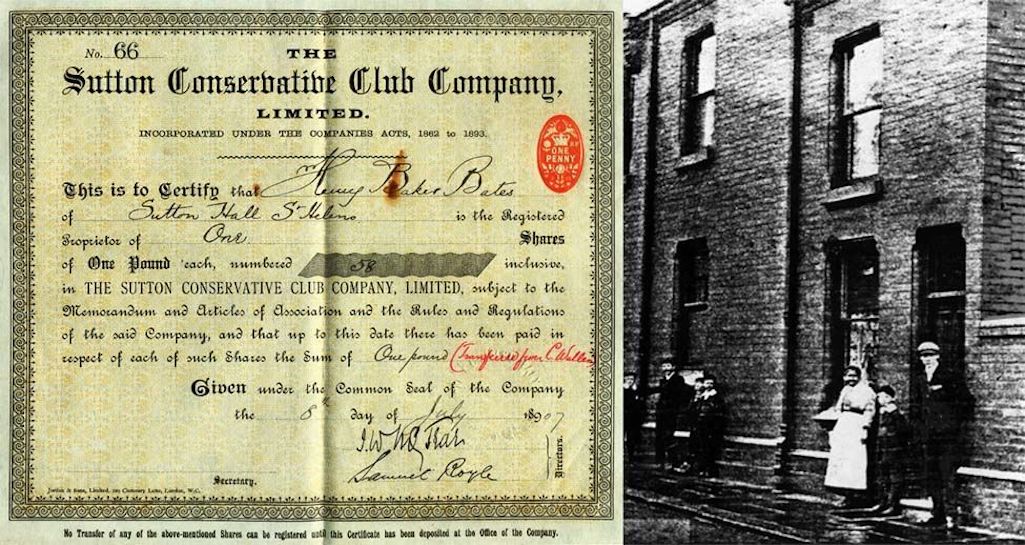
Left: Share certificate owned by Henry Bates - Contributed by Merrick Baker-Bates; Right: Conservative Club & Caretaker’s House c.1900

Share certificate and Sutton Conservative Club & Caretaker’s House c.1900

Left: Share certificate; Right: Sutton Conservative Club & Caretaker’s House
The secretary of the Conservative Club by 1891 was Thomas Woods and an annual tea party and concert was held. However through limits on the numbers that the club could accommodate, once again the event had to take place at Sutton National School. So a larger club was built in 1900 at 4 Edgeworth Street, near to the Victoria Vaults / Little Pig pub, which was officially opened on May 2nd by Henry Seton-Karr, M.P. for St.Helens. He was presented with a special gold-mounted key by Colonel McTear in which to open its doors.
A limited company was created to pay for its funding and shares in the Sutton Conservative Club Company Limited were purchased by its supporters. In the Liverpool Mercury's report of the opening ceremony, they described how the ground floor of the building served as an assembly room and the upper floor included a 'large billiard saloon'. There was also a lounge and bar and a room for playing cards and dominoes. A well-kept bowling green was at the rear of the premises and the caretaker of the new club was "Sandy" McKinnon, whose house was next door (pictured right). As well as Colonel McTear, Conservative councillor Dr. Baker Bates was also heavily involved in getting the new club built.
Excursions to seaside resorts took place annually and many weddings and birthday parties were held on the ground floor of the Conservative Club, which was licensed for dancing and music. A Junior Conservative meeting was held on Friday nights, known as Sutton Junior Imps, which included music and dancing. This was very popular and it's said that many courtships began on these nights. As well as billiard and games rooms, the upper floor provided access to a steel constructed balcony that overlooked the bowling green. A steel staircase led down to the green and to a bowls house. The club was finally demolished in 1987. Another Conservative Club was built in Marshalls Cross Road in Peasley Cross in 1914.
There was also an East Sutton Liberal Club in Junction Lane, which was formally opened by Arthur Sinclair on May 31st 1886. The speakers at the opening ceremony warned of the dangers of the new club degenerating into a “gambling saloon”, as Charles Walsh, who chaired the gathering, put it. The branch club had already attracted over 100 members by the time of the opening and membership quickly grew.
On August 1st 1887 about 700 Liberals from the club travelled to the village of Hawarden in Wales to see their hero William Gladstone and present him with a mirror. This had been specially made by Parr Bros., which was owned by the sons of George Parr of Mill Lodge in Sutton, a vice president of the club. Unfortunately the ‘grand old man’ - as Gladstone was then known - was not at home when the party arrived. In November 1889 the owner of the club – who rented the premises to the Liberals for £23 8s. per year – put it up for auction. An advertisement stated that the area of the site, which included a shop and living quarters for a caretaker, measured 150 square yards.
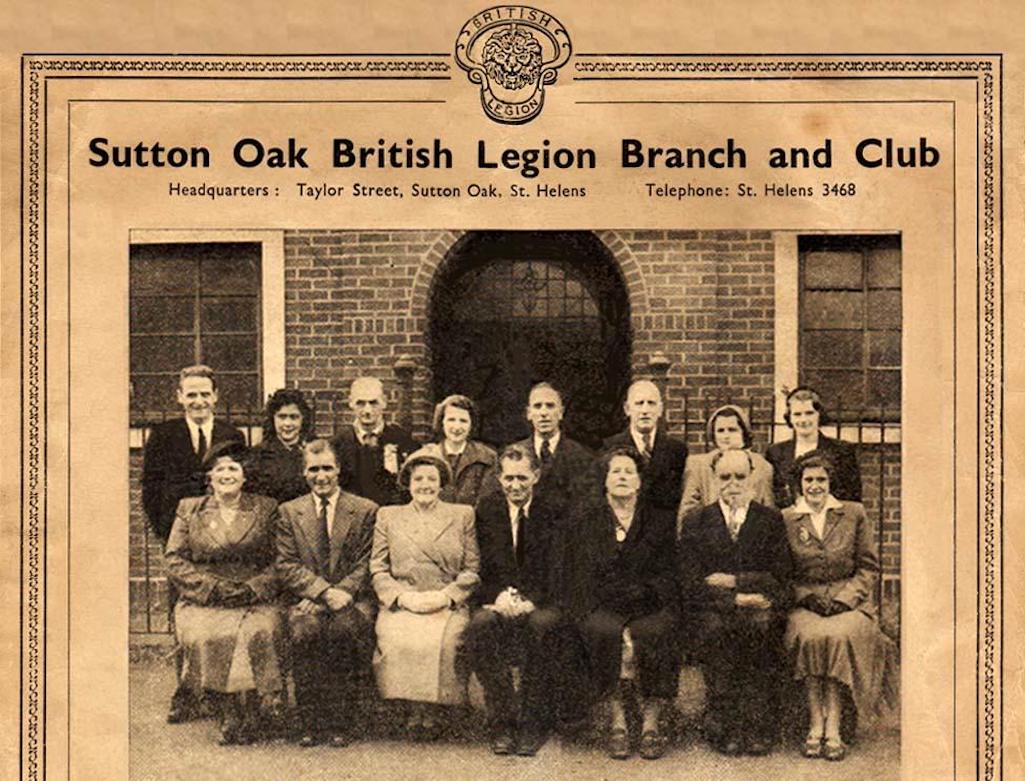
Part of a Sutton Oak British Legion poster - they were renowned for their concerts - Contributed by Margaret Crosbie

Sutton Oak British Legion poster - they were renowned for their concerts

Sutton Oak British Legion poster
However on September 19th 1936, the Sutton British Legion Club was opened by Dr. Donald Campbell on the old Showfield between Edgeworth Street and Peckers Hill Road. It was known for its concerts which were held every Sunday evening and their Good Friday concerts were especially popular.
Beecham’s Social Club was situated off Sutton Road in Bentinck Street. On September 2nd 1968 the pharmaceutical firm held their first gala, which they hoped would become an annual event. The opportunity was also taken to officially open the club’s new indoor pool, which the company had paid £4,500 for and which measured 50 feet by 20 feet. Two hundred members attended the club’s Guy Fawkes’ Night celebrations that year.
The East Sutton Labour Club in Ellen Street is the only club that still remains within this part of Sutton. The present building is of relatively recent construction, although it did exist as a smaller, wooden building as far back as the 1920s, if not earlier. It has certainly lasted much longer than the Sutton Working Men's Club, which on February 9th 1906 was struck off the register of clubs for not having the required number of members. It had only been formed in 1900 and never had more than 28 enrolled members.
By 1906 the club, which appears to have been situated in Junction Lane, only had 16 members, nine less than the minimum number of 25 that licensed clubs were required to have. The secretary of Sutton Working Men's Club was William Wilson of 89 Junction Lane, who told a licensing hearing that his members “kept falling off” and that he had only learnt over the past three months that the Licensing Act of 1902 required a minimum of 25 members.
Moving north down Marshalls Cross Road there was the Peasley Cross Labour Club. Writing on the Sutton Beauty & Heritage Facebook page Sheila Rattigan wrote how Bob Grice had been the compere at the Labour Club for years. “He was a brilliant singer, he always sang ‘We wish you a last goodbye’ at the end of the night and he'd wave a white hanky. Happy days!”.
Industrial clubs were often linked to sport, such as the London & N.W. Railway Recreation Club at St.Helens Junction, which also served as a pavilion for football, cricket and athletics games. Railway employees could become members for a subscription of a penny per week, with others able to join for 5 shillings a year. By 1889 the membership list had grown to 250 and the railway company decided to invest in larger premises. A new brick and stone building with pitchpine roof was built at a cost of £600 adjacent to St Helens Junction station, with a 60 feet-long multi-purpose room. During the day it was used for dining and during the evening it served as a reading room and as a venue for evening classes and concerts.
Of the 20th century sports and social clubs within the Sutton district, Sidac’s off Applecorn Close by Leach Lane is noteworthy. Built in 1961 by British Sidac, the Sutton Leach club was taken over by its former employees after the cellophane maker left Sutton. Their football section dates back to 1936 and is the oldest member of the St Helens Football Combination League.
The club, which was recently refurbished, is thriving and boasts two function rooms with many activities regularly held. Work began during May 2018 to create grass playing fields in Sherdley Park for use by Sidac Social Club, as well as changing rooms and perimeter fencing. The lease of the club's old fields in Sutton Leach was sold in 2017 to a housing developer who is building 117 homes on the site. The developer agreed to build the playing fields as part of the deal and St Helens Council granted Sidac a 25-year peppercorn lease for exclusive use of a section of Sherdley Park. The St Helens Darts Academy - which has more than 50 five to eighteen-year-old members - relocated to Sidac in 2016 after the closure of Our Lady’s Club in Parr.
During 2018 Clock Face Miners’ Recreation Club has similarly survived the closure of its works and runs two adult football teams, an adult rugby team and eight junior rugby teams. Mention should also be made of the Rechabites of Sutton, whose tent (or lodge) was known as ‘Providence’ and centred on temperance. At a meeting of tents from the Liverpool district at Knowsley Park on August 10th 1889, more than half of the St.Helens contingent came from Sutton. The other two St.Helens tents, incidentally, were known as ‘Perseverance’ and ‘Great Heart’.
It’s also worth mentioning in this section the New Street Community Centre, which opened in Autumn 1979 at a cost of £350,000. It incorporated a library that held up to 15,000 books as well as two large halls for drama and youth activities. The main hall when opened seated 250 to 300 people, with stage and changing rooms. There were also workshop and craft rooms, together with smaller spaces for general meetings and a coffee bar plus lounge. A warden’s flat was provided for the manager of the complex. The first one was Haydock-born Derek Atkinson, a former Captain with the Salvation Army. The centre still exists but the library has long closed.
The St Helens / Sherdley Show (1968 - 2006)
Sherdley Park came under municipal ownership in the late 1940s and at over 300 acres, it was the obvious venue for hosting large-scale events. The biggest was the annual St Helens Show which took place between 1968 and 2006. The origins of the 'Sherdley Show', as it was locally known, can be traced back to 1780 with the biennial St Helens Fair in New Market Place.In later years the St Helens Show was run by the Royal Lancashire Agricultural Society, although held very infrequently. In fact the 1901 show, which was held in Grange Park, was the first to be held in the town for 45 years! The organisers lost £333 on the event, due to the attendance being less than expected and the spending of a whopping £2264 on medals and prizes. This was because the show centred on the showing and competing of livestock classes and wasn’t centred on entertainment, like its later incarnation.
The modern-day St.Helens Show was initially a one-off Centenary Show to celebrate 100 years of the St Helens borough. It was opened by the Mayor of St.Helens, Councillor Tom Forshaw, who ended up being booked by the police! After opening the show, Cllr. Forshaw went up in a balloon, which had to make a forced landing to avoid storm clouds. Seconds after landing, close to the old Burtonwood airbase, two police officers were on the scene. They took the mayor's name and asked him "Didn't you see the notice saying Trespassers Will Be Prosecuted"?
The success of the show led to it being held on an annual basis and at its peak it attracted half a million visitors over three days. Billed as the largest free show in Europe, the event consisted of air and field displays, demonstrations and shows, arena entertainment, mother & baby and Miss St.Helens competitions, music performances, an impressive fireworks display on the final day and Silcocks Fair.
Prior to Sherdley Park coming under municipal ownership, Silcocks would spend several weeks on wasteland in Watery Lane with their 'Great Star Amusements'. Their adverts in the St Helens' newspapers in 1943 said their Sutton Pleasure Fair contained "all the latest juvenile riding devices and side shows of every description. Also the Chair-o-Planes, Loop-the-Loop, Noah's Ark. Roll Up! Roll Up!"
In 1993 it was estimated that 550,000 people attended the "Sherdley Show", as locals often called it. However, with increasing competition from other forms of entertainment plus, as some people claimed, a tired, repetitive format, the numbers of attendees considerably decreased and the St.Helens Show ended in 2006. The following year it was replaced by the two day St.Helens Festival which for four years was held earlier in July and attracted about 20,000 visitors in total before its cancellation by St Helens Council.
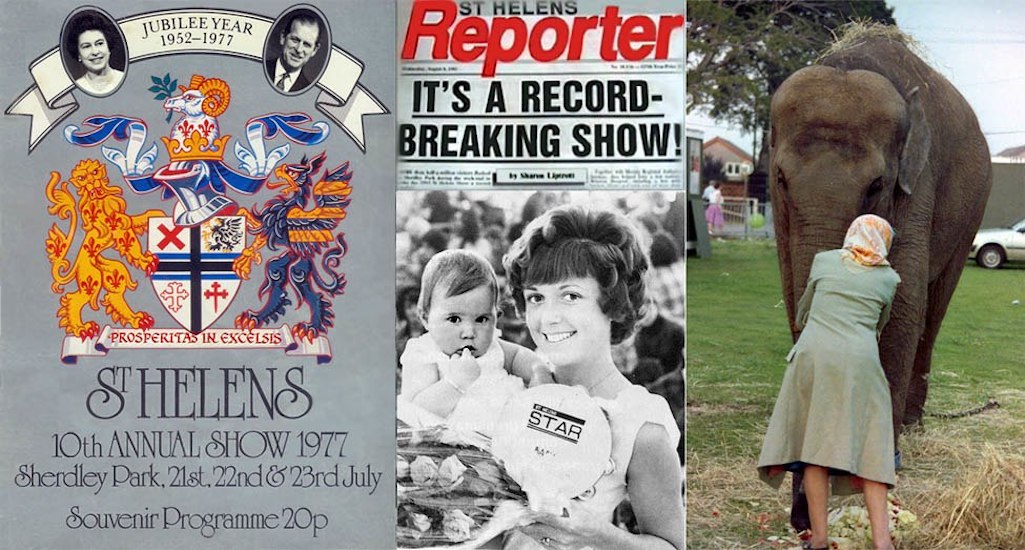
Cover of 1977 Show programme plus Mother & Baby competition; Top: St.Helens Reporter 1993; Right: Elephant at the Show

1977 Show programme, Mother & Baby competition, St.Helens Reporter 1993

1977 Show programme, Mother & Baby competition & St.Helens Reporter 1993
